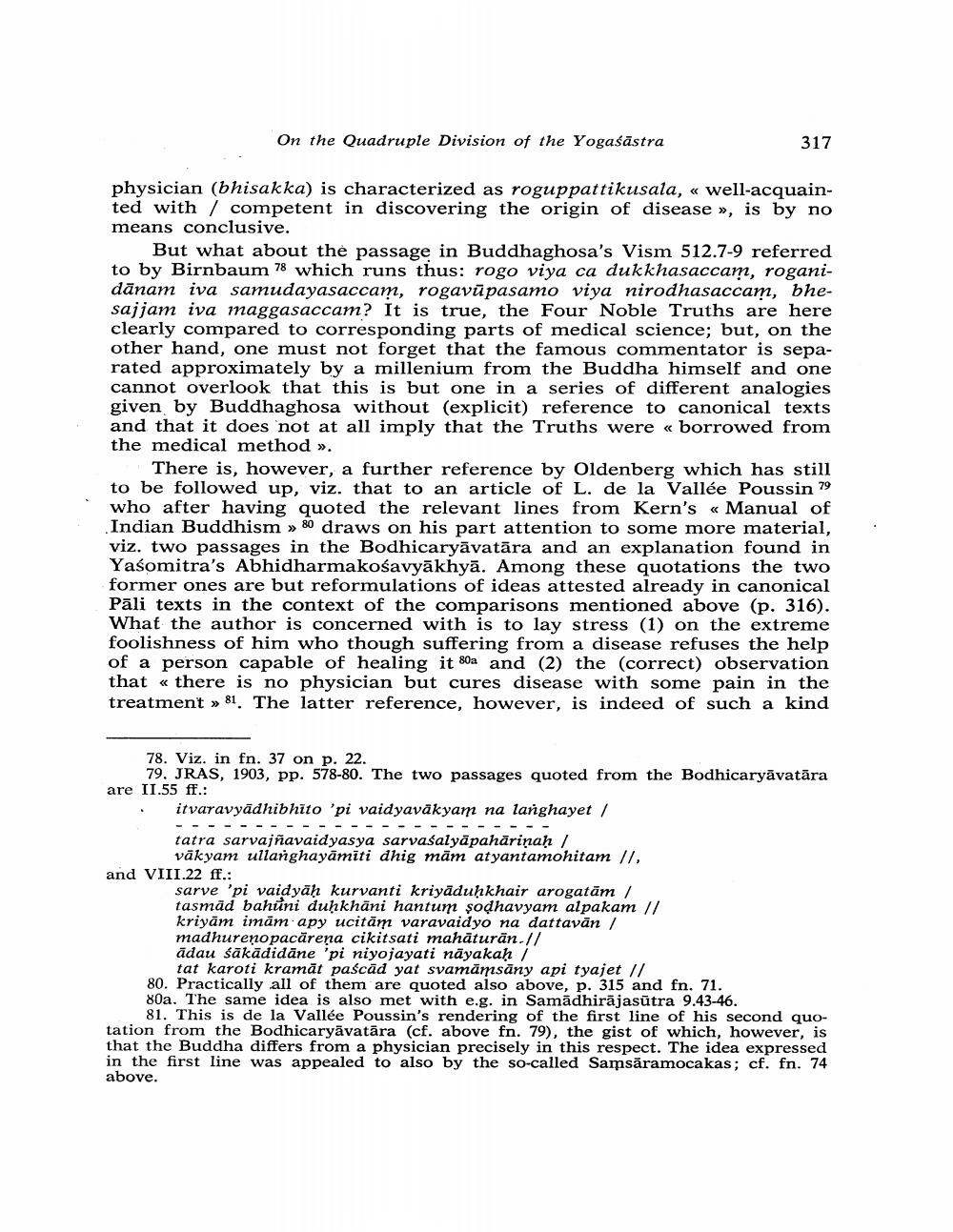________________
On the Quadruple Division of the Yogaśästra
317
physician (bhisakka) is characterized as roguppattikusala, well-acquainted with / competent in discovering the origin of disease »>, is by no means conclusive.
But what about the passage in Buddhaghosa's Vism 512.7-9 referred to by Birnbaum 78 which runs thus: rogo viya ca dukkhasaccam, roganidanam iva samudayasaccam, rogavūpasamo viya nirodhasaccam, bhesajjam iva maggasaccam? It is true, the Four Noble Truths are here clearly compared to corresponding parts of medical science; but, on the other hand, one must not forget that the famous commentator is separated approximately by a millenium from the Buddha himself and one cannot overlook that this is but one in a series of different analogies given by Buddhaghosa without (explicit) reference to canonical texts and that it does not at all imply that the Truths were « borrowed from the medical method ».
There is, however, a further reference by Oldenberg which has still to be followed up, viz. that to an article of L. de la Vallée Poussin 79 who after having quoted the relevant lines from Kern's « Manual of Indian Buddhism » 80 draws on his part attention to some more material, viz. two passages in the Bodhicaryāvatāra and an explanation found in Yasomitra's Abhidharmakośavyākhyā. Among these quotations the two former ones are but reformulations of ideas attested already in canonical Pāli texts in the context of the comparisons mentioned above (p. 316). What the author is concerned with is to lay stress (1) on the extreme foolishness of him who though suffering from a disease refuses the help of a person capable of healing it and (2) the (correct) observation that << there is no physician but cures disease with some pain in the treatment »> 81. The latter reference, however, is indeed of such a kind
78. Viz. in fn. 37 on p. 22.
79. JRAS, 1903, pp. 578-80. The two passages quoted from the Bodhicaryāvatāra are II.55 ff.:
itvaravyadhibhito 'pi vaidyavakyam na langhayet /
tatra sarvajñavaidyasya sarvasalyapahāriṇaḥ / vākyam ullanghayāmīti dhig mam atyantamohitam //, and VIII.22 ff.:
sarve 'pi vaidyaḥ kurvanti kriyāduḥkhair arogatām / tasmäd bahuni duḥkhani hantum şodhavyam alpakam // kriyām imām apy ucitām varavaidyo na dattavan / madhurenopacāreņa cikitsati mahāturan.//
adau sākādidane 'pi niyojayati nayakaḥ /
tat karoti kramat paścãd yat svamämsäny api tyajet // 80. Practically all of them are quoted also above, p. 315 and fn. 71.
80a. The same idea is also met with e.g. in Samadhirajasūtra 9.43-46.
81. This is de la Vallée Poussin's rendering of the first line of his second quotation from the Bodhicaryavatāra (cf. above fn. 79), the gist of which, however, is that the Buddha differs from a physician precisely in this respect. The idea expressed in the first line was appealed to also by the so-called Samsaramocakas; cf. fn. 74 above.




